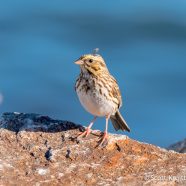Bad Hair Day
Don’t worry, Savannah Sparrow, bad hair days happen to all of us. Speaking of that, our collective feathers and hair are all about to be blown away. We had a warm and very not November-like stretch but the snow is coming to Chautauqua County! Be safe and enjoy the beginning act of the winter season.
Read MoreBlue Jay
This Blue Jay (Cyanocitta cristata) was in the shade on a sunny April day, nevertheless showing off blue hues against a blue sky and flying around with its mate. In this case the blues are not as blue as they could be because they are not actually blue. Huh? Their feather barb cells are specially modified scatter light in a way that makes them appear blue instead of what would be brown melanin, and if this bird flew into the sunlight then it would pop even more. Scott Kruitbosch Conservation & Outreach Coordinator
Read MoreFlicker Feather
This feather is another find from exploring the outdoors this weekend with my dog Zach. The number of birds with long yellow feathers around in the autumn or winter seasons is relatively short, and it looks like a Northern Flicker (Colaptes auratus). Roger Tory Peterson saw this brilliant flash of gold in a flicker’s wings and it helped inspire him to change the world. What always makes me use my imagination is thinking about seeing a deep red explosion coming from a Northern Flicker bursting from the ground. The red-shafted forms fill the American west, and someday I hope to go see...
Read MoreVesper Sparrow
It took a while, but I finally got my fall Vesper Sparrows! My friend and sensational birder and naturalist Frank Mantlik found these two beauties in the Stratford community gardens among many other Song, Savannah, Swamp and White-throated Sparrows. They later cooperated, ever so briefly, for a couple photos. These big sparrows look so wonderful with those huge eye rings, and one was really showing off those white feathers… Scott Kruitbosch Conservation & Outreach Coordinator
Read MoreMelanistic House Sparrow (Passer domesticus)
This is one House Sparrow (Passer domesticus) I have never seen before! I took these shots last weekend, the bird being part of a group of well over 100 House Sparrows. The photos are very true to real life appearance and have not been heavily edited. Do you know why it is so dark? It appears to be melanistic which means that the dark-colored pigment melanin in the feathers was produced at higher than normal levels creating an abnormal color. The opposite is known as leucism where pigments are produced at less than normal levels or in an unexpected pattern. Melanism in small songbirds is...
Read More








